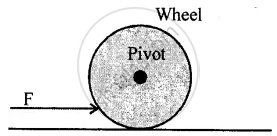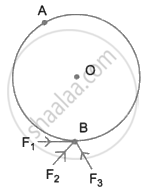Advertisements
Advertisements
Question
How does the effect of force differ when it is applied on a rigid body?
Solution
When a force applied on a rigid object it does not change the interspacing of constituent molecules and does not change dimensions and can cause motion in it.
APPEARS IN
RELATED QUESTIONS
State the effect of force F in of the following diagram.

Find the moment of force of 20 N about an axis of rotation at distance 0.5 m from the force.
State one factor on which the magnitude of a non-contact force depends. How does it depend on the factor stated by you?.
Define couple.
Give an example for each of the following uses of a machine:
to change the point of application of force
The diagram shows a uniform metre rule weighing 100gf, pivoted at its centre O. Two weights 150gf and 250gf hang from the point A and B respectively of the metre rule such that OA = 40 cm and OB = 20 cm. Calculate :
the total clockwise moment about O

The diagram shows a uniform metre rule weighing 100gf, pivoted at its centre O. Two weights 150gf and 250gf hang from the point A and B respectively of the metre rule such that OA = 40 cm and OB = 20 cm. Calculate :
the difference of anticlockwise and clockwise moment

The diagram shows wheel O pivoted at point A. Three equal forces F1, F2 and F3 act at point B on the wheel.

- Which force will produce maximum moment about A?
- Give a reason for your answer in (a).
The diagram in Fig shows two forces F1 = 5 N and F2 = 3 N acting at points A and B respectively of a rod pivoted at a point O, such that OA = 2 m and OB = 4 m.

Calculate:
- the moment of force F1 about O.
- the moment of force F2 about O.
- total moment of the two forces about O.
